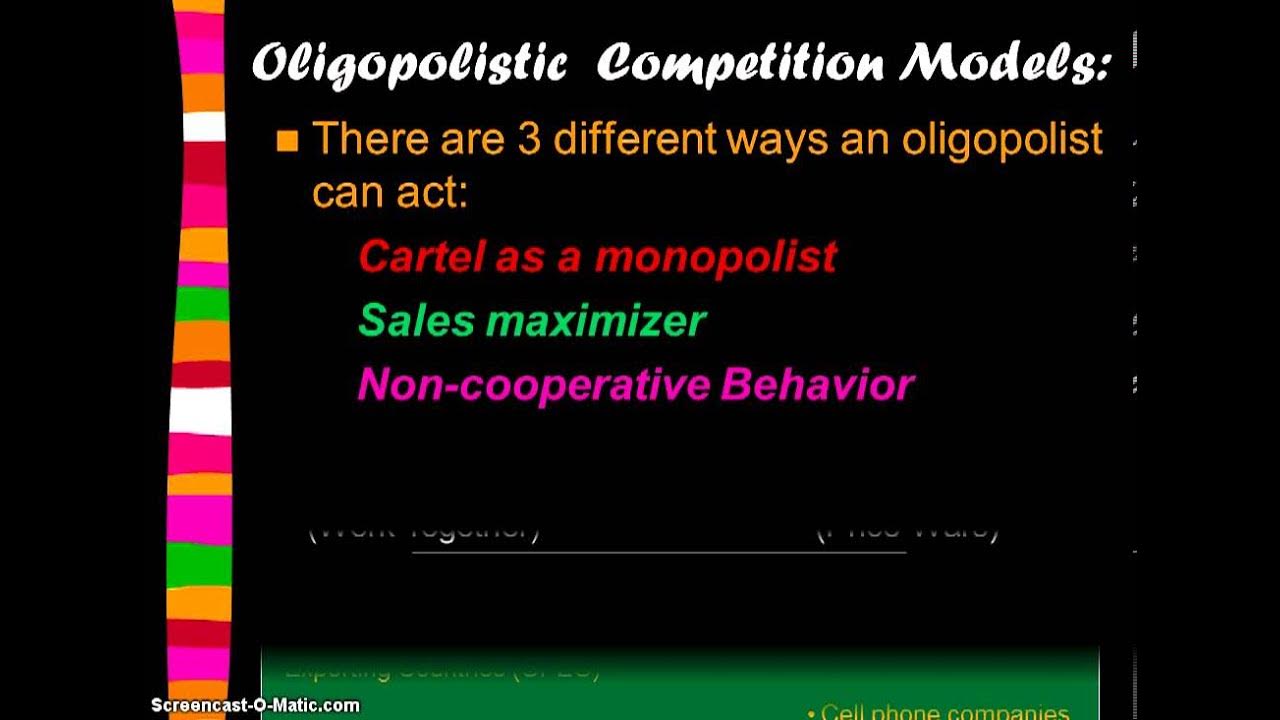Kurva Pasar Oligopoli Jangka Pendek Jangka Panjang
Summary
TLDRThis educational video delves into the concept of oligopoly markets, explaining the unique behavior of firms with few competitors. It highlights how demand curves in oligopolies are shaped by the actions and reactions of companies to price changes. The video also covers price rigidity, profit scenarios (supernormal profits, normal profits, and losses), and how firms make production decisions based on Marginal Revenue and Marginal Cost. Additionally, it explores long-run outcomes where firms typically settle into normal profit levels. The explanation uses visual aids to simplify the concepts of market structure and firm behavior in oligopolies.
Takeaways
- 😀 Oligopoly is a market structure with a few producers, not defined exactly, but typically less than 10 or in the range of dozens.
- 😀 In an oligopoly, firms experience a unique demand curve that reflects 'action-reaction' behavior between producers.
- 😀 The demand curve for oligopoly firms is characterized by segments where price increases lead to significant loss in customers, while price decreases do not substantially attract new customers due to competitors matching price cuts.
- 😀 The demand curve for oligopoly is split into two parts: elastic at the top and inelastic at the bottom, reflecting differing consumer reactions to price changes.
- 😀 A firm in an oligopoly will face a kinked demand curve, with the 'kink' reflecting the point at which producers adjust their pricing strategy based on competitors' actions.
- 😀 Firms in an oligopoly often engage in price rigidity, meaning prices tend to stay stable because both increasing or decreasing prices may not lead to significant benefits.
- 😀 The marginal revenue curve in an oligopoly is always steeper than the demand curve, and it has two parts: one for the initial demand curve and another for the altered demand curve after reactions.
- 😀 In the short run, firms in oligopoly markets can experience supernormal profits, normal profits, or losses, depending on market conditions and pricing strategies.
- 😀 Supernormal profits occur when total revenue exceeds total cost, and firms are able to charge prices higher than what would occur in perfect competition.
- 😀 When oligopolies experience normal profits, their total revenue equals total costs, leading to a stable market environment with no incentives for firms to alter their production strategies.
- 😀 In cases of losses, firms may reduce output or seek other cost-reduction strategies, but there are still barriers to exit due to the nature of the oligopoly market structure.
Q & A
What is the key focus of the video in terms of market structure?
-The video focuses on explaining the demand curve in oligopoly markets, discussing how producers in such markets react to price changes and how this leads to a unique demand curve shape.
What does 'oligopoly' mean in the context of the video?
-Oligopoly refers to a market structure where a few producers dominate the market, often resulting in high competition and interdependent pricing strategies.
How does the demand curve in an oligopoly differ from that in a monopoly?
-In an oligopoly, the demand curve is more unique and segmented due to the reactive nature of competing producers. Unlike monopolies, where a single producer controls the market, oligopolists' prices are influenced by competitors' actions.
What happens when a producer in an oligopoly lowers its price below a certain threshold?
-If a producer lowers its price below a critical level, other producers typically react by also lowering their prices, leading to limited gain in market share and profits.
Why does an oligopoly's demand curve have segments that are not experienced by producers?
-The demand curve has segments that are not experienced because certain price levels trigger competitive reactions. For instance, lowering the price too much results in other producers cutting prices too, which nullifies the initial gain.
What is meant by 'price rigidity' in an oligopoly?
-Price rigidity refers to the phenomenon in oligopolistic markets where prices tend to stay stable due to the interdependent nature of producers. Any price change by one producer is likely to trigger a similar response from others, keeping prices within a certain range.
What is the role of the marginal revenue curve (MR) in oligopoly markets?
-The marginal revenue curve in an oligopoly is important for understanding the additional revenue gained from selling one more unit of a product. In oligopolistic markets, the MR curve is unique because it is derived from the unique demand curve shaped by competitive reactions.
What are the three possible outcomes for a producer in the short run in an oligopoly?
-In the short run, a producer in an oligopoly can experience three possible outcomes: supernormal profits, normal profits, or losses. The exact outcome depends on factors like pricing strategies and market competition.
How do oligopolistic producers decide on the optimal level of production?
-Oligopolistic producers determine their optimal level of production by ensuring that their marginal revenue equals marginal cost (MR = MC). This maximizes their profits or minimizes losses.
What is the significance of the total revenue (TR) curve in analyzing oligopoly markets?
-The total revenue curve is crucial in oligopoly markets as it helps producers understand their total earnings based on different pricing strategies. It assists in identifying the optimal price and quantity that maximizes revenue and profitability.
Outlines

This section is available to paid users only. Please upgrade to access this part.
Upgrade NowMindmap

This section is available to paid users only. Please upgrade to access this part.
Upgrade NowKeywords

This section is available to paid users only. Please upgrade to access this part.
Upgrade NowHighlights

This section is available to paid users only. Please upgrade to access this part.
Upgrade NowTranscripts

This section is available to paid users only. Please upgrade to access this part.
Upgrade Now5.0 / 5 (0 votes)





